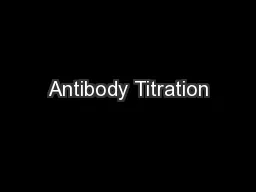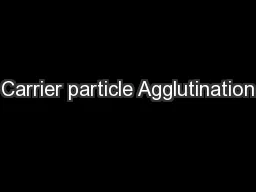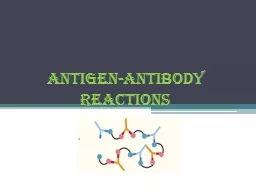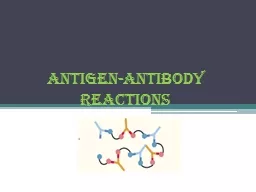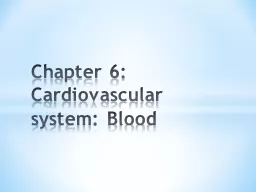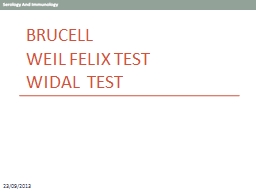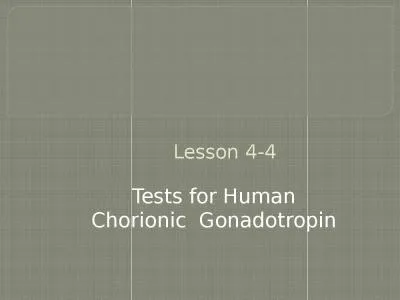PPT-Agglutination
Author : lindy-dunigan | Published Date : 2017-09-28
Agglutination The interaction between antibody and a particulate antigen results in visible clumping called agglutination Particulate antigen include bacteria
Presentation Embed Code
Download Presentation
Download Presentation The PPT/PDF document "Agglutination" is the property of its rightful owner. Permission is granted to download and print the materials on this website for personal, non-commercial use only, and to display it on your personal computer provided you do not modify the materials and that you retain all copyright notices contained in the materials. By downloading content from our website, you accept the terms of this agreement.
Agglutination: Transcript
Agglutination The interaction between antibody and a particulate antigen results in visible clumping called agglutination Particulate antigen include bacteria white blood cells red blood cells . Lab 6. Practical . Blood Bank. Antibody Detection. The test used to detect antibodies is called an . antibody screen. Antibody screens are used for:. Patients needing a transfusion. Pregnant women. Cases of transfusion reactions. Lab 9. Practical . Blood Bank. Titration is a semi quantitative method used to determine the concentration of antibody in a serum sample. or . to compare the strength of antigen expression on different red cell samples. . Practical . Blood Bank. Blood Transfusion Process. Pre-transfusion. Transfusion . Post-transfusion. What is compatibility testing?. Also called pretransfusion testing. Purpose. :. To select blood components that will not cause harm to the recipient and will have acceptable survival when transfused. Latex agglutination. flocculation. Carrier particle agglutination test. Agglutination test: Qualitative/ Quantitative(Ab titer) agglutination test. It is used to determine Ag or Ab. presence and amount(. reactions. Let’s start. The immune system is a system of biological structures and processes within an organism that protects against disease.. . To function properly, an immune system must detect a wide variety of agents, from viruses to parasitic worms, and distinguish them from the organism’s own healthy tissue. . (RA. ). . RA . is a chronic, systemic inflammatory disorder of unknown etiology characterized by the manner in which it involved . joints. Progressive joint destruction and deformity leads to variable degrees of . Let’s start. The immune system is a system of biological structures and processes within an organism that protects against disease.. . To function properly, an immune system must detect a wide variety of agents, from viruses to parasitic worms, and distinguish them from the organism’s own healthy tissue. . Functions of blood . Transport. Defence. Regulation. H. 2. O. Composition of blood: . cells, platelets. 45%. plasma. 55%. % . by Volume. Plasma. Water (91%). Hormones. Gases. Ions. Vitamins. Nutrients. The . immune system. is a system of biological structures and. . processes. within an . organism. that protects against . disease. . . To function properly, an immune system must detect a wide variety of agents, from . Reneé. . Wilkins. , . PhD, MLS(ASCP). CM. CLS 325/435. School of Health Related Professions. University of Mississippi Medical Center. Importance. It is important to recognize discrepant results and how to (basically) resolve them. Assistant Professor. Department of Veterinary Medicine. Bihar Veterinary College, Patna. (Bihar Animal Sciences University, Patna. ). Brucellosis . (Contagious abortion, Bang disease). . The genus . Widal. test. Brucell. Gram negative small . coccobacilli. .. Non- motile.. None encapsulated.. Fastidious, need special media with CO. 2. and anaerobic condition for growth these media called as . T. a. t. y. ana. . Ivakhnyuk. The D. epartment. . . of. . I. nfectious. . D. iseases. . and. . E. pidemiology. . with C. ourse. . of. . M. icrobiology. , . V. irology. . and. . I. mmunology. Human . Chorionic Gonadotropin. hCG or uCG . Hormone of pregnancy. Produced by the placenta. Detectable 1 week after implantation. Rapid tests available. Development of Pregnancy Tests. Ancient methods used urine.
Download Document
Here is the link to download the presentation.
"Agglutination"The content belongs to its owner. You may download and print it for personal use, without modification, and keep all copyright notices. By downloading, you agree to these terms.
Related Documents


